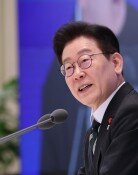Message from wave of Taegeukgi
Message from wave of Taegeukgi
Posted February. 28, 2015 07:16,
South Korean President Park Geun-hye addressed in the U.S. parliament called as Capitol Hill during her visit to Washington in May 2013. In the picture that captured the moment, what catches eyes is the Stars and Stripes widely spread behind the chairpersons seat. How does it look in the plenary session room of the Korean National Assembly? Large-sized badge for National Assembly members is hung at the center of the wall and Koreas national flag Taegeukgi is displayed on the flagpole, not at the center, but on the side, next to the chairpersons seat.
Why did the Korean coast guard fire at the Japanese ship Unyo, when the ship displayed Japanese national flag? In January 1876, Japan raised the issue of national flag and demanded Korea to sign an unequal treaty between Japan and Korea, which opened up the secluded nation. The then Korean government was not aware of modern concept of a national flag. Korean Ambassador Park Young-hyo made a flag with a red-and-blue circle surrounded by four trigrams on a ship heading for Japan on Aug. 9, 1882. The current Taegeukgi was announced as Koreas national flag in October 1949.
Recently there are a lot of controversies over Taegeukgi. President Park Geun-hye emphasized patriotism mentioning a scene in the movie "Ode to My Father," in which main characters stopped whatever they were doing when the national flag was descending from a flag pole. The presidents comment came under criticism from left-wing groups that it was an "obsolete and outdated view." Ahead of Koreas Independence Movement Day, domestic media outlets reported that the Ministry of Government Administration and Home Affairs launched a campaign to raise the national flag on national holidays and started efforts to revise related laws. Many people held mixed views such as Is it an attempt to go back to the military government, or Naysayers are trying to interpret raising the national flag as a political agenda. Taegeukgi is a fruit of patriotism. It is inappropriate to have ideological debates over raising Taegeukgi or the allegiance to the nation.
Independence activist Moon Yong-gi, who led a rally in Iksan, a southern region of South Korea, during the 1919 Independence Movement, held the Taegeukgi in his left hand when a Japanese policeman cut his right hand that was holding the national flag. Even after the Japanese police cut his left hand again, Moon shouted independence of Korea and passed away. Now we can enjoy freedom to raise our national flags that ancestors gave their lives to defend, but people seem to have forgotten the importance of Taegeukgi. Whenever Japan provokes over its past wrongdoings during the wartime, the entire public raises their voice. Still, many flagpoles remain empty in the residential areas on national holidays. On the March 1 Independence Movement Day, I wish to see the nation is covered by wave of Taegeukgi. It will repay the debt that we owed to our ancestors who gave their lives to gain independence and deliver a silent message to Japan.




![[속보]법원 “12·3 계엄은 내란…한덕수, 절차적 요건 갖추게 해”](https://dimg.donga.com/c/138/175/90/1/wps/NEWS/IMAGE/2026/01/21/133201789.1.jpg)

![‘50만원짜리 김밥’ 알고보니…환불 반복에 자영업자 폭발했다[e글e글]](https://dimg.donga.com/c/138/175/90/1/wps/NEWS/IMAGE/2026/01/21/133200737.3.jpg)
